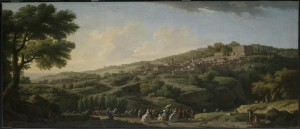 In the upcoming program, Elements, Tempesta salutes a moment when nature got big. In the 1600 and 1700’s, the outdoors beckoned and people went out to meet it. It’s as if someone threw the windows open all across Europe and cultured ladies and gentlemen started breathing in big, draughts of delicious fresh air. They might not have gone all the way to doffing wigs and panniered skirts to run barefoot across the fields. But they started down the path.
In the upcoming program, Elements, Tempesta salutes a moment when nature got big. In the 1600 and 1700’s, the outdoors beckoned and people went out to meet it. It’s as if someone threw the windows open all across Europe and cultured ladies and gentlemen started breathing in big, draughts of delicious fresh air. They might not have gone all the way to doffing wigs and panniered skirts to run barefoot across the fields. But they started down the path.
Fresh, simply-sauced vegetables began appearing on elegant dinner tables. Explorers and merchants came back from travel with stories about far-away wonders and exotic bulbs and plants that Europeans eagerly snapped up. Naturalists and scientists, armed with insatiable curiosity and new scientific methods, made discoveries almost faster than scientific societies formed to report on them. Landscape painting came creeping out of the corners of figure paintings to take on new prominence, even dominating in paintings by Claude Lorrain and Salvator Rosa.
Composers rushed to bring the outside world into concert halls, providing lush soundtracks for nature themes in operas and ballets. An exciting new palette of tone colors provided by new instruments like double basses, bassoons, oboes, flutes, and virtuosic recorders helped orchestras bring nature sounds to teeming life.
Tempesta di Mare offers a lovely, fresh bouquet of baroque nature music for its last show of the season. In Marin Marais’s opera Alcyone, 1706, the sea and its changeable vistas are featured, including a “tempest” scene that was famous in its time for kick-out-the-jams orchestral ferocity. One hundred measures of howling strings and woodwinds (baroque style) rattles the rafters before the music reverts to the “halcyon days” promised by the opera’s title.
Georg Philipp Telemann’s Water Overture celebrates nature’s beneficence in the form of the River Elbe, source of the port of Hamburg’s prosperity. Commemorating the city admiralty’s centennial in 1723, it’s a musical love poem to the river and its moods: sleepy currents, cheerful boatsmen, a squall (German audiences liked storms, too) and the graceful ebb and flow of tides.
And in a dramatic finale, J ean-Féry Rebel’s ballet Éléments, 1737-’38, represents nature as seen through the eyes of science. It opens with a brutal chord composed of all the notes of the d-minor scale struck simultaneously—crash!—expressing the chaotic discord of base matter before the origin of life. It’s a sign of the times: science was such a red-hot popular topic in 18th-century France that a ballet about Platonic essentials was a rousing success at the Paris Opera. And the power of modern science gets a special, hopeful treatment in Elements: after that startling prologue, “Chaos” resolves into sweet harmony, and the immutable laws of nature proceed to be enacted as a charming suite of French dances.
ean-Féry Rebel’s ballet Éléments, 1737-’38, represents nature as seen through the eyes of science. It opens with a brutal chord composed of all the notes of the d-minor scale struck simultaneously—crash!—expressing the chaotic discord of base matter before the origin of life. It’s a sign of the times: science was such a red-hot popular topic in 18th-century France that a ballet about Platonic essentials was a rousing success at the Paris Opera. And the power of modern science gets a special, hopeful treatment in Elements: after that startling prologue, “Chaos” resolves into sweet harmony, and the immutable laws of nature proceed to be enacted as a charming suite of French dances.
Baroque nature in Tempesta’s Elements isn’t pain and emotionalism, awe and splendor like it would be in the later 18th and 19th centuries. It isn’t Tennyson’s “nature, red in tooth and claw.” That’s for future generations to worry about. This nature is the dewy dawn of the “best of all possible worlds,” as the indomitable optimist Pangloss calls it in Candide, the novel by 18th-century French philosophe Voltaire. It’s sunshine, and zephyrs, and if there’s a storm, there’s the calm after the storm, too. For a while, in June, Tempesta di Mare will give us our halcyon days.
While I’m waiting, I’m going for a walk.
